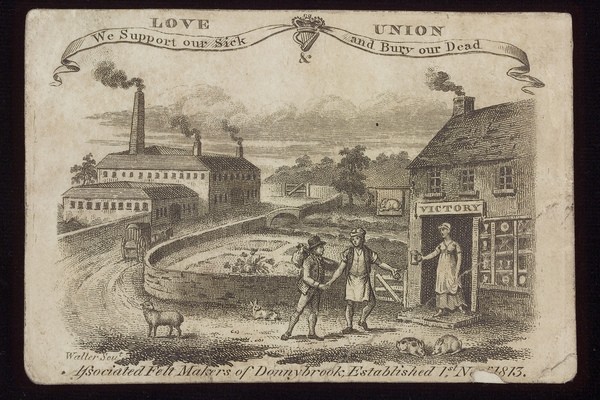
A facsimile of the union card of the Donnybrook hatmakers in the 1800s.
Pic: Glenda Cimino
Learn about Donnybrook’s hidden history of Wesleyans and Mad Hatters this weekend!
In 1813, Mr John Wright and his two brothers set up a beaver hat factory in Donnybrook, building a row of cottages to house its workers. These workers are said to have come from Yorkshire, and there was also a shop, a Wesleyan Methodist Church and a school (which has since been demolished) built to service their needs. The mystery remains as to why this industry dried up and the workers left so quickly, whether it was due to an increase in the price of the imported beaver pelts or their scarcity, or that the popular style changed to silk hats, with the factory unable to adapt to meet the new demand.
To celebrate this moment in Donnybrook’s history, 9 Beaver Row will be opening its doors to the public for Heritage Week. Prepare to be welcomed to the Tea Party alongside Alice (Rebecca Flynn) by The Mad Hatter (Degnan Geraghty) and the Dormouse (James Martinez), before the fun is interrupted by the Queen of Hearts (Rebecca Blomfeld)!
This one-off event is being staged by actor, writer and director Glenda Cimino, who explained that the figure of the Mad Hatter – made famous in Lewis Carroll’s Alice’s Adventures in Wonderland – actually had a basis in reality: “Many people do not realise that hatters were ‘mad’ because of inhaling mercury fumes from the hatmaking process. Long term exposure to mercury could cause neurological damage, rashes, tremors, and other symptoms that led to hatters being considered mad.”
There will also be a reenactment of Mr Wright (Noel Joyce), along with his friends, Protestant Minister Rev. Gideon Ouseley (Dick O’Leary), and Union organiser Jeremiah (John Kavanagh) recruiting workers for the hat factory. Members of the public will also be invited to apply for a job, receiving a membership to the Donnybrook Felters Union of 1813, complete with a union card! The events of the day are also to be made into a documentary. “We are making it as historically accurate as possible, but there is still so much we don’t know. It will hopefully be a bit of fun.”
Glenda’s interest in the history of Beaver Row was sparked by her neighbours when she moved there in 1974: “I learned a lot also from the older residents of the row, who have now all passed on, and I wrote a historical essay about the Wesleyans and hatters for a local history course in Maynooth a couple of years ago.”
The event will last about 20 minutes and will repeat throughout the afternoon from 2 to 6pm on Saturday and Sunday. There is no need to book, but keep in mind that each group will be kept to a maximum of about ten.
By Aimée Mac Leod



